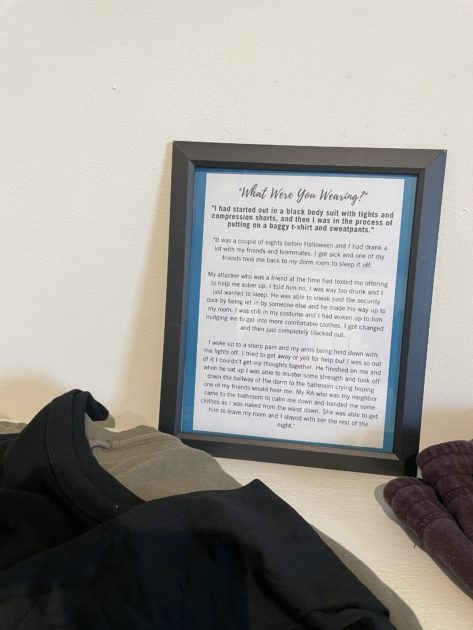Please note: The following article discusses sexual assault.
Schumacher Gallery is bringing light to sexual assault misconceptions through their “What Were You Wearing?” exhibit.
For the past two years during April, sexual assault awareness month, the gallery has displayed recreations of the outfits sexual assault survivors were wearing at the time of their assault.
The art installation is a collection of sexual assault experiences anonymously shared from students, faculty and staff.
The display is meant to encourage conversation and break down stereotypes that often come with discussions of sexual assault, such the stereotype that the victim’s clothing somehow provoked the assault.

The Office of Student and Community Engagement, Schumacher Gallery and the Title IX office partnered to put this exhibit together.
Schumacher’s exhibit is inspired by the “What Were You Wearing?” installation that originated at the University of Arkansas in 2013.
The original project was inspired by Dr. Mary Simmerling’s poem, “What I Was Wearing.”
Sophia Wilson, associate director of Student and Community Engagement, was one of the individuals who helped bring this installation to life.
When she began working at the university in 2021, she knew this installation was something she wanted to bring to the university.
“Power-based violence is something that impacts the entire community, and survivors of such violence deserve a place to share their stories and experiences,” Wilson said.

Members of the Capital community who wished to participate were asked to share their stories along with what they were wearing at the time of the assault. Their responses were collected through an anonymous form.
“From there, we began to slowly compile outfits based on what was shared and tried to be mindful of collecting a variety of sizes and styles to emphasize the diversity of individuals and the fact that anyone can be a survivor of sexual assault,” Wilson said.
The outfits were put on display, with the written stories alongside it. Many of the stories displayed were deeply personal and emotional.
“The bravery of survivors will only continue to encourage conversation and communal learning, so we can improve campus culture,” Wilson said.
Wilson believes asking survivors “What were you wearing?” often takes the blame off the offender and places it on the victim.

“Myths and stereotypes aid perpetrators of crime in avoiding accountability for their choices and the harm they cause to others,” Wilson said. “As a society, we need to stop asking this harmful question because it continues to preserve rape culture.”
The exhibit highlights the variety of clothing items victims were wearing at the time of their assault, conveying the message that clothing does not invite sexual violence.
“It reminds viewers that clothing is never the cause and certainly does not provoke violence in any manner…” Wilson said. “If only ending sexual violence was as easy as changing our clothes.”
In the future, Wilson hopes to continue partnering with Schumacher Gallery annually to keep bringing awareness to many of the harmful stereotypes surrounding sexual assault.


